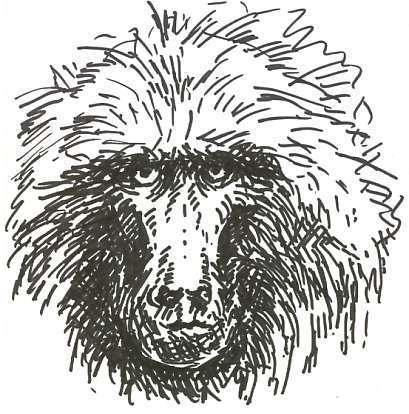BABOON
A DASART PROJECT PROPOSAL
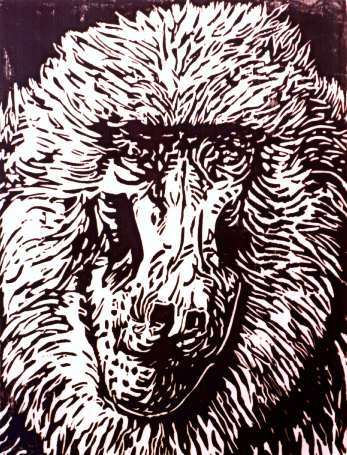
January 2002
The Concept:
It is generally conceded that the 21st century requires social adjustments from humanity if we are to survive beyond it. The burdens upon the environment are myriad and it is necessary to recognize and understand our position within the broad environmental matrix. This exhibition will focus on the interrelationship between man and baboon. Because we regard the baboon as beneath us in social status, we do not place taboos against knowledge that we place on human society. It is possible, for example, to examine baboon sexuality in a way that we cannot our own. The baboon shares 98% of our DNA and its behaviour has remarkable similarities to our own. This project seeks to hold up a mirror that will reflect many aspects of our society through the medium of the baboon.
Cultural manifestations like Religion give us guidelines on how to behave, yet powerful primal forces seem to break out irrespective of religious strictures. Often it is religion itself that becomes barbarous and cruel. The Spanish suppression of Mayan culture is a good example. In Africa, Christianity worked hand in hand with forces of Capitalism and Colonization to subjugate a continent. The original, animistic beliefs were eradicated and denigrated. The rise of Muslim Fundamentalism has had extremely harsh social and political consequences for sectors of the population, like women.

Dasart wishes to create an installation that explores our primal nature. It will exhibit the characteristics of self-organizing structures. These occur in nature, for instance, in clouds. The moving currents of air cannot be seen but the shape of the cloud reveals the presence of energy. The type of structure indicates the type of energy flow. The artist(s) will explore the theme from different perspectives. There will also be contributions by people in other disciplines besides art, such as poets and environmentalists. The final installation will reflect the energies of a brain by means of a network of associations.
Story-Telling
Ancient African culture linked its well-being with animals. There was also a strong connexion between animals and man in Aztec society. Similarly, Native American culture has a strong bond with animals and environment. These links are maintained through myths and legends. Dasart believes that there is a need to reassert these methods of communication. Environmental education relies on people being taught ideas that are culturally determined by First World countries. However, the appropriate myths and attitudes towards the land are already contained within all cultures and need only be activated.

Why Baboons?
Although Baboons are indigenous to Africa, they are also exploited by American research laboratories so we feel that the theme will be universally relevant. Their body parts are used in human transplants and they are important in the fight against Aids, since the virus does not affect them.
In South Africa, these animals are considered to be vermin and are shot or poisoned to eradicate them. They are also used extensively in scientific and medical laboratory experimentation. They undergo horrific vivisection and psychological experiments to facilitate scientific understanding of human physionomy. The pharmaceutical world tests new drugs on them. Medical surgeons transplant baboon hearts into deficient human patients. The baboon is also used and abused by traditional African healers who market body parts and make potions from substances like baboon faeces. The baboon is kept and fed within a 45 gallon drum!
Baboons also do not elicit sympathy from common society, but are seen as ferocious and destructive pests. In zoos, people laugh and tease them even though the funny aspects are when they caricature humans the most. Ugly racial aspects of human nature also emerge when people are denigrated as baboons. In essence, they are commodities within an exploitative capitalistic culture, much the same as slaves.
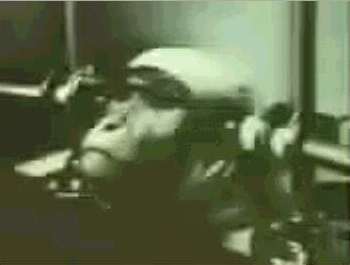
Rehabilitation centres like CARE attempt to relocate these animals after they are released from experimentation facilities or farmers’ traps. Currently they have about 300 damaged baboons awaiting relocation. They are unable to find an area where the baboons are acceptable and the relocation can take place. Human society cannot co-exist with the Baboon. However, Eugene Marais in The Soul Of The Ape, describes abilities of magnetic compassing far beyond our capabilities. His study reveals that baboons also exhibit many of our sexual characteristics and family bonds. By segregating human society from animals we have lost a frame of reference.
Reality
Dasart believes that a new perception of ‘Reality’ is necessary. Theories of Quantum Mechanics and Relativity show that, on a philosophical level, the world needs to be understood through the patterns of energy that manifest. Society presently views ‘Reality’ as objects in space, a perception given theoretical form by Descartes in the 18th century. A modern approach would stress the energies passing through all things at a sub-atomic level. A Dasart installation combines an object-based perception with an understanding of the underlying energies that pervade objects and spaces. This means that to a certain extent the individual art object is swallowed by the whole. The identity of the artist is also subsumed so that the art is free to interact without a signature. The patterns of energy within and around the art work can then initiate meaning for the viewer.
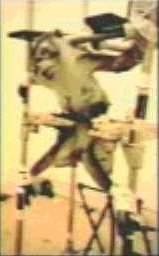

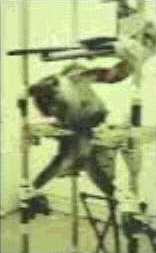
Individuality is seen as a hindrance to the integration of man with environment. This is because the energies interconnecting all things deny individuality. Political, religious and other social mechanisms that served to socialise man must be adapted to integrate man with environment. Population growth, resource depletion and nationalistic capitalism are disastrous for the world. Ancient societies like the Aztecs had a higher regard for the animal and saw it as a link to a mysterious power. We think we should tap into this again in order to realign man with environment. The “I” has to get an increment of meaning so as to include the environment.
The Works Envisaged
Overall, the installation will present work in a variety of media. These include traditional media like sculpture, drawing and painting as well as video, digital and others that artists wish to use. The exhibition will be a network of associations by artists who will be free to respond to the theme as they see fit. Dasart installations rely upon a way of organising that relates to Complexity Theory. This type of installation is self-organising and encourages variety as opposed to Reductionism which encourages a stylistic exclusion. Dasart uses a variety of people that include artists and experts in other fields. This allows the content of the installation to become more broad-based and inclusive. We encourage ambiguity and contradiction, fragmentation and discontinuity, time and timelessness, loss and regeneration.
The ideal setting would consist of various interconnecting spaces which have thematic links. Textual explanations at the entrance to each room guide the viewer to the specific focus of the work in the room. The rooms are divided into two halves as in a brain. There are correlations between rooms on either side.
Room 1: A large sculpture of a baboon sitting, made from welded recycled materials, which is accompanied by sound emanating from an old metal box. The recording is of an old lady recounting childhood memories of the baboon she owned, called coincidentally Johnson. The sound is staccato-like and consists of discrete communications rather than continuous storytelling. The baboon is made from a real skeleton that is coated with thin pieces of rusted metal soldered together. Hair and wood are also used in the sculpture. The form sits on a dilapidated concrete plinth and gazes through steel bars. The soundbox is positioned outside the bars. Surrounding the structure are images from the bygone colonial past of Pietermaritzburg, South Africa, where the story originated.
Room 2: A darkened room has video projections of several explorations of cages running simultaneously with overlaps. These are projected onto entire walls. The videos explore manipulating time and space in their structure. The effect will be like waves of mesh and concrete surrounding the viewer. The sound will be mechanical gratings and scratching noises as might be made by bolts closing or other zoo-like sounds. The viewer should experience a sensation of being caged and confused.
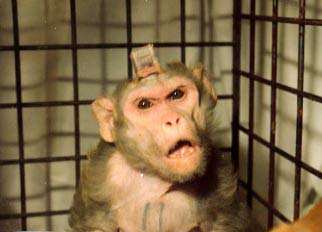
Room 3: A room which has a religious sub-text exhibits a variety of religious paraphernalia which have been subverted so that the baboon becomes the votive object. Vitrines of Saints foreskins and fingers now contain baboon body parts. These are simulated fibreglass and latex interventions. Crucifixion altarpieces are reconstituted with baboon protagonists. These will be large oil paintings. The Shroud of Turin is reproduced photographically with a baboon corpse. A photographic record of the procedure may also be included in the display. Basically, a corpse gets hung and turned over a period of 4 days in front of a camera obscura which contains a photosensitized cloth. The image is burned into the cloth over time and then fixed.
( I am not sure if this room will only have Catholic Christian influences or also include other religions as well )
Room 4: This room explores the use and abuse of baboons in African traditional medicine and lore. Credo Mutwa, the African shaman, has written extensively on the subject and I hope to interact with his ideas. Large photographic images of baboon corpses and the use made from these by traditional muti or medicine will be on the walls. Baboons are also kept in 45 gallon drums so as to obtain their faeces for medicinal and magical purposes. This room might also recreate this procedure. A baboon made from a real skeleton and covered in metal, hair and wood will be placed into a 45 gallon drum. A sound track will expound on African folklore about, and uses for, the baboon. This will emanate from a metal box or from the drum itself.
Room 5: This room considers a human preoccupation with exchanging body parts. There are several paintings that confuse baboon and human physiognomy, with themes like rape and bestiality. In the Western medicinal context, baboons have importance because they are almost identical to humans, sharing 98 percent DNA. They are also immune to AIDS. Thus many operations and experiments have taken place to transplant baboon bone marrow and hearts into ailing humans. This room will document some of this material. It will mainly take the form of text and photographs.
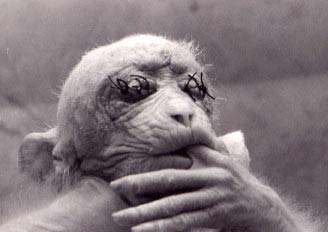
Room 6: Video images of a confrontation between baboon and human faces, like a slanging match, show aspects of racial intolerance. The images constantly morph into a moving pattern of ugliness. The bark of a male baboon is piped throughout the show. Flashing insults are traded in text and speech, though in a confused and inchoate style. Racial statements, rhetoric and folk wisdom are presented in a spirit of reasonableness or commonsense.
Room 7: The focus here will be on vivisection and psychological experiments conducted on baboons. There are large scale charcoal drawings of baboons undergoing vivisection experiments. Photographic and textual documentation of the experiments and visualizations of the restraining devices will also be presented. Dr Wouter Basson, aka ‘Dr Death’, who assisted the Apartheid regime get rid of enemies chemically, was the head of the vivisection unit in Roodepoort, Gauteng. Animal rights activists document some of their activities. CARE is an organisation dedicated to rehabilitating and relocating these damaged baboons. Part of the installation will focus on their work and ideas stemming from it.

Room 8: Sexuality and social bonding. Paintings and photographs that transpose baboons into frameworks normally reserved for human imagery, for example, a portrait of a baboon in a heavy stucco gilt frame. These are interspersed with images of human interaction. There will also be scientific material on baboon sexuality and social behaviour, for example, comparisons between states of arousal (in oestrus) between baboons and humans. The prime means of communication will be the juxtaposition of images that represent equivalents between baboon and human society.
Room 9: A mathematical scientist, Darcy Thomson, studied baboon and human proportion just after the 19th century and concluded that by altering the mathematical formula for human proportions, we get the baboon. These ideas will be displayed via computer aided design and will possibly be interactive.
Room 10: A large imitation metal baboon, motorized, air-filled plastic swinging around in a darkened room with stroboscopic lights flashing. The wild movement and the lights will establish a disjunction since they are set at different intervals. The sound will be like wind or a bullroarer.
In all I anticipate 5 artists working on the different elements. Most of the mini installations will combine work by different artists.
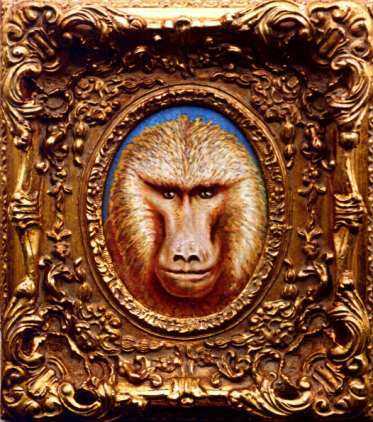
Satellite Activities
We intend to produce a book for sale that will contain documentation of the exhibition as well as poetry, essays and other interesting paraphernalia. It will have a narrative element as well. This will take a similar form to magic realism and thematically it will deal with the history of South Africa as observed by a baboon. This baboon resides within onion layers of reality and can pass into a variety of forms. Time and space are relative to this shape-changing. The material will also be available on a CD ROM. Printed images like woodcuts, etchings and other multiples will be included in the book.
Contact Details
Dasart
Ashley Johnson
Tel/fax: 27 (11) 948 9992
Email: [email protected]
